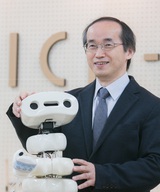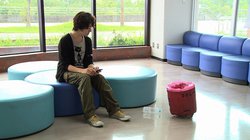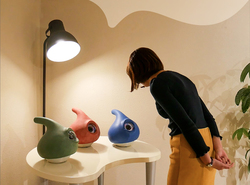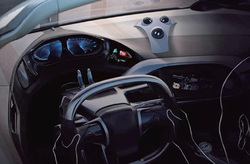
Okada, Michio
| Affiliation | Department of Computer Science and Engineering |
|---|---|
| Concurrent post | Research Center for Collaborative Area Risk Management (CARM) Institute for Research on Next-generation Semiconductor and Sensing Science (IRES²) |
| Title | Professor |
| Fields of Research | Cognitive Science / Social Robotics / Human-Robot Interaction / Interaction Design |
| Degree | Dr. Eng. |
| Academic Societies | Japanese Society for Ecological Psychology / Human Interface Society / Information Processing Society of Japan / Japanese Cognitive Science Society |
| okada@ Please append "tut.jp" to the end of the address above. |
|
| Laboratory website URL | http://www.icd.cs.tut.ac.jp |
| Researcher information URL(researchmap) | Researcher information |
Research
We are conducting researches on underlying the mechanisms of embodied human-human communication and social interaction from multidisciplinary perspectives, such as social robotics, cognitive science and interaction design.
Theme1:Social Robotics and Human-Robot Interaction Studies
Overview
When we observe our bodies from an external perspective, we see everything. We see that our bodies seem complete or self sufficient. However, when we look at our bodies from an internal perspective there are multiple things that we can’t see/ process. We can’t see our faces or our backs, which in turn allows us to understand that we aren’t really self-sufficient/complete. We use these ecological psychology perspectives to recruit those/things around us to help and build robots with relational capabilities (social robots who use their imperfections as strength).
From our research on proto communication, we have created robots such as
- the Sociable Trash Box: This robot can’t pick up trash on its own, but by cleverly drawing out help from children, the Sociable Trash picks up trash.
- i-Bones: A robot that nervously draws out the kindness and help from people to give out tissues.
- Talking Ally: Drawing out help from the listener, Talking Ally starts conversations and needs the help of the listener to keep the conversation going.
- Muu: Making conversation without words, Muu is a robot who makes conversation with multiple people.
Selected publications and works
- Naoki Ohshima , Yasuke Ohyama, Yuki Odahara, P. Ravindra S. De Silva, and Michio Okada: Talking-Ally: The Influence of Robot Utterance Generation Mechanism on Hearer Behaviors, International Journal of Social Robotics, Volume 7, Issue 1, Pages 51-62 (2015).
- Yuto Yamaji, Taisuke Miyake, Yuta Yoshiike, P. Ravindra S De Silva and Michio Okada: STB:Child-Dependent Sociable Trash Box, International Journal of Social Robotics, Volume 3, Number 4, Pages 359-370 (2011).
Keywords
Theme2:Cognitive Science in Our Everyday Communications
Overview
Can’t communicate when trying to but communicating when not trying to. Our true research focuses on trying to draw out help from those around us by ways of subtraction design and conversation through minimal spontaneous sounds. We hope that these points of research will lead to new communication methods. Furthermore our lab looks to find a constructive approach to the aspect of human-human proto-communication.
Here are several of our research focuses:
- Pursuing the involvement of participants in order to communicate and use minimal cues to bring about communication.
- Developing robots based on isomorphism in relation to the environment and human-robot proto-communication.
- Research on body-body communication through the use of Pelat; the unsteady wandering robot who walks alongside you by holding your hand.
Selected publications and works
- Youssef Khaoula, Michio Okada: Gracefully Mitigating Communication Protocol Reuse Breakdowns, Journal of Communications, Vol.12, No.3, pp.187-193 (2017).
- Khaoula Youssef and Michio Okada: How a Minimally Designed Robot can Help Implicitly Maintain the Communication Protocol, Internal Journal of Social Robotics, Volume 9, Issue 3, pp 431–448 (2017).
Keywords
Theme3:Interaction Design and Social Implementation
Overview
By adding more capabilities and raising the functionality of systems, we become more passive and even arrogant at times towards the way we use robots or systems. Our lab in essence, is focused on creating and socially implementing an interactive design which excels in drawing out human kindness, schemes/strategy, and a new way to learn.
-Our research focuses on creating a design which focuses on a relational developmental
learning place as well as developing a type of care where if one takes care of something, said person will receive care in return.
- An example of this would be Talking-Bones, which is a robot who sometimes forgets the important words of a conversation and requires the help of the participant. As a result of helping Talking-Bones, the participant feels accomplished and happy to help the “imperfect” robot.
- Another focus point is to construct the symbiosis theory through NAMIDA, a level 3 robotic (conditional automation) autonomous driving system. These little agents create a cooperative environment with the driver in which, both NAMIDA and the driver draw out each others weakness, while building on those weakness to create a stronger bond.
Selected publications and works
- Nihan Karatas, Soshi Yoshikawa, Shintaro Tamura, Sho Otaki, Ryuji Funayama and Michio Okada: Sociable Driving Agents to Maintain Driver’s Attention in Autonomous Driving, 26th IEEE International Symposium on Robot and Human Interactive Communication (RO-MAN), 2017.
- Nihan Karatas, Soshi Yoshikawa, P. Ravindra De Silva, Michio Okada:NAMIDA: How to Reduce the Cognitive Workload of Driver, Human-Robot Interaction (HRI2016), pp. 449-450, 2016.
Keywords
Title of class
Data Analysis Theory / Multivariate Analysis Theory / Human Interface Design / Robot Informatics
Others (Awards, Committees, Board members)
◆ 2017: 平成29年度科学技術分野の文部科学大臣表彰「科学技術賞」(科学技術振興部門)
◆ 2022: 第31回 大川出版賞
◆ 2019: 第19回ヒューマンインタフェース学会論文賞
◆ 2016: ICSR2016 Best Robot Design (Special Recognition) Award
◆ 2016: HAI2016 Outstanding Research Award
◆ 2016: HAI2016 Impressive Poster Award 優秀賞
◆ 2015: RO-MAN2015 Best Paper Award Finalist
◆ 2014: HAI2014 Impressive Poster Award
◆ 2013: HRI2013 Honorable Mention Demonstration Award
◆ 2012: HAI-2012 Outstanding Research Award 最優秀賞
◆ 2012: HAI-2012 Impressive Experience Award
◆ 2012: ICSR2012 BEST ROBOT DESIGN AWARD
◆ 2010: 第11回ヒューマンインタフェース学会論文賞
◆ 2010: HRI 2010 The Best Late-Breaking Report Award
◆ 2010: ICSR 2010 Best Paper Finalist
◆ 2010: HAI2010 Outstanding Research Award 優秀賞




